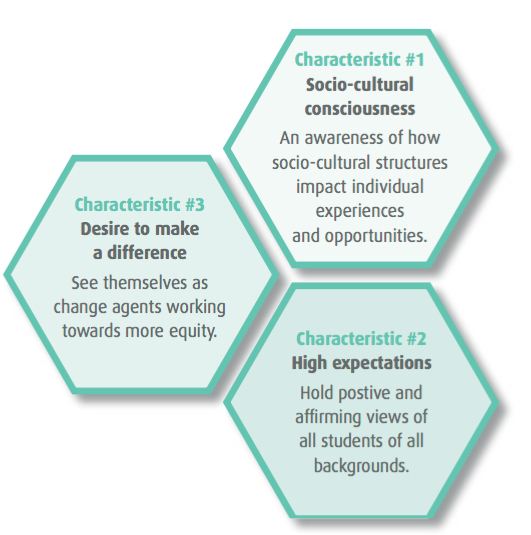May
2017
Culturally Responsive Pedagogy
Culturally responsive pedagogy is a student-centered approach to teaching in which the students’ unique cultural strengths are identified and nurtured to promote student achievement and a sense of well-being about the student’s cultural place in the world. (http://www.huffingtonpost.com/matthew-lynch-edd/culturally-responsive-pedagogy_b_1147364.html)

From the Capacity Building Series, Culturally Responsive Pedagogy:
Towards Equity and Inclusivity in
Ontario Schools
This is such a huge and important topic. For this post, I decided to address this theme through the lens of Intercultural Understanding (which is a focus in every strand of Ontario’s Grades 4-8 Core French Program) and share a little bit about how I strived to create a culturally responsive classroom environment.
I was struck by the line in the Student Identity and Engagement in Elementary Schools: Capacity Building Series that stated:
When teachers explore student identity in the spirit of discovery and out of authentic caring for each student as a whole person, meaningful relationships develop.
This reminds me of the work of Dr. Jean Clinton who consulted for the Ministry of Education on the new Kindergarten Program (2016) and wrote The Power of Positive Adult Child Relationships: Connection Is the Key. As educators, we know how powerful relationships can be – both with students, parents and colleagues – for creating and sustaining safe, healthy, equitable and inclusive learning environments that honour and respect diversity.
One of the strategies that I have used in the past has been to send a note home at the beginning of the year, inviting parents and students to help me promote intercultural understanding. Here is the text:
Intercultural Understanding in Core French – How you can help!
Learning about different cultures is an important part of the new Core French curriculum. As in years past, I will occasionally include posts about celebrations and traditions that are meaningful to students in my classes, but I need your help: If there is a celebration or tradition that is special to your family, please let me know about it! (Celebrations and traditions need not be religious in nature, for example, if your family has an awesome movie night tradition, that is worth sharing too as that is also part of our Canadian culture!)
Thanks to my students and their families, every year I learn something new in this department! Let’s keep it up!
This initiative proved to be transformative, both for myself and my students. Families sent in photos of their holiday tables, students surprised me with essays about their celebrations, others came in traditional dress and performed dances for us. We all learned a ton! A homeroom teacher colleague of mine once ask how I knew so much about the kids’ cultural events. I told her the truth: I just asked!
As a parent of children who do not celebrate the majority culture, I can say from experience that it is so much easier for families to walk through a door that has been opened than to have to first open the door and then walk through it.
Other strategies I have tried/could try are:
- Honouring a child’s first language by having the child or the family teach me how to say hello, thank you and well done in their native tongue;
- Co-creating a class book with family photos for each child;
- Creating class profiles so as ensure that I am addressing the various learning styles and multiple intelligences of my students;
- Involving the children in the design of the classroom environment and units of study, but being aware that if the dramatic play area is always subject to a vote, then only majority voices may get heard (i.e., Christmas, Halloween, Valentine’s Day, etc…)
- Recognizing that every child learns in a unique way and honouring the space and time they need to optimise their learning.
Further resources I explored include:
The Learning Exchange – Culturally Responsive: Educator Mindset and Action, which includes some great videos.
Culturally Responsive Pedagogy: Towards Equity and Inclusivity in Ontario Schools, which is where the top image comes from.
Learning Disabilities and Diversity: A Culturally Responsive Approach, which includes the statement,
Educators attempting to teach about a culture they do not identify with risks perpetuating assumptions and stereotypes about certain social groups. When implementing a culturally responsive pedagogy in the classroom, the role of the educator is to create a platform where cultural knowledge can be shared; it is a learning opportunity that allows student to see: “Knowledge building is reciprocal because students play an active role in crafting and developing learning experiences for themselves and their peers. This results in making learning relevant and accessible for all students in the classroom as they are able to see themselves in the curriculum. (OME, 2013, p. 5)”
This is a subject that is near to my heart. Can you tell!?
**This is part of a series of posts that I am writing based on prompts from my Integration of Information and Computer Technology in the Classroom Part 2 course.**
SaveSave
SaveSaveSaveSave
stephanieelkabbouchi
May 13, 2017 at 1:33 pm (7 years ago)Wow! I love how you just simply ask the students and parents about their culture. This helps you grow a deeper connection with the families and the students feel valued. It’s hard when your friends don’t celebrate the same things as you and you feel as though you’re ‘different’. Great idea! I’ll have to try it!